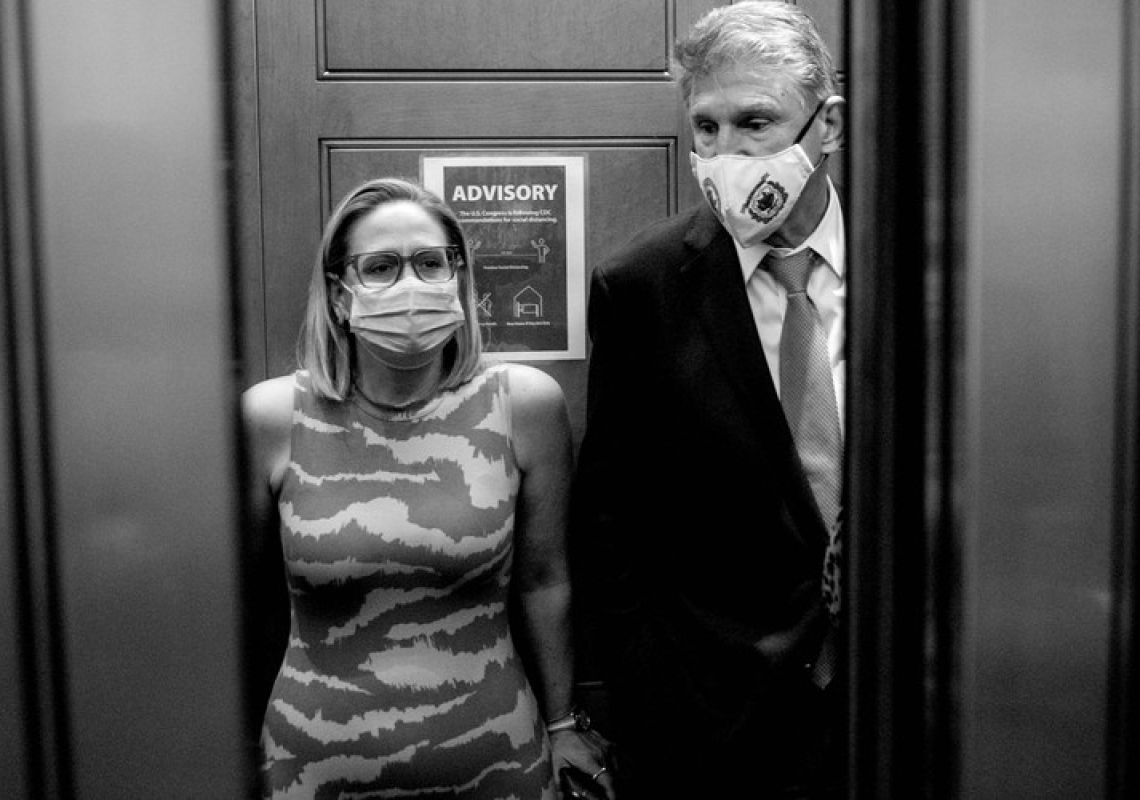A nationwide standard of voting rights now seems like a pipe dream.
The decision by Senators Kyrsten Sinema and Joe Manchin to block their fellow Democrats from passing new federal voting-rights legislation clears the path for years of tightening ballot restrictions in Republican-controlled states. It also marks a resounding triumph for Chief Justice John Roberts in his four-decade quest to roll back the federal government’s role in protecting voter rights.
Roberts as much as anyone set in motion the events that have led to this week’s climactic Senate confrontation over voting legislation. In a series of rulings over the past 15 years, the Supreme Court, often in decisions written by Roberts himself, has consistently weakened federal oversight of voter protections and struck down federal regulations meant to reduce the influence of money in politics. Almost all of those decisions have unfolded on a strict party-line basis, with the Republican-appointed justices outvoting those appointed by Democrats.
Those decisions have had an enormous practical impact on the rules for American elections. But many voting-rights advocates say that the rulings have been equally important in sending a signal to Republican-controlled states that the Supreme Court majority is unlikely to stand in their way if they impose new restrictions on voting or extreme partisan gerrymanders in congressional and state legislative districts.
Democrats are still pressing the two senators to reconsider their decision before this week’s votes. Barring an unlikely last-minute reversal of their position, Manchin and Sinema have effectively blocked federal voting-rights legislation by insisting that it remain subject to a filibuster that provides Senate Republicans a veto. And that could trigger a renewed red-state offensive.
Read: Democrats stare into the abyss
“We’re going to see a new wave of [state] legislation that is just as dangerous as what we’ve seen [so far] and that is going to create additional barriers to the ballot,” Deborah Archer, an NYU School of Law professor and the president of the American Civil Liberties Union, told me.
Roberts, who served as a young clerk to conservative Supreme Court Justice William Rehnquist and as a Justice Department assistant in the Reagan administration, has long expressed hostility to federal oversight of voting and election rules. As the journalist Ari Berman recounted in his 2015 book, Give Us the Ballot, Roberts “led the charge” against the bipartisan 1982 reauthorization of the Voting Rights Act, which ultimately reversed a Supreme Court decision (supported by Rehnquist) weakening one key section of the law. Roberts wrote “upwards of 25 memos” opposing the legislation’s provision requiring that the Justice Department prove only discriminatory “effect” rather than purposeful “intent” in order to block state or local voting restrictions. (The Court had ruled the opposite, severely limiting the law’s applicability.)
In one memo reported by Berman, Roberts revealed his broader philosophy about voting rights: The test for federal objection to local voting laws should be extremely difficult to meet, he wrote, “since they provide the basis for the most intrusive interference imaginable by federal courts into state and local processes.”
That approach has guided Roberts on the Supreme Court. As the Harvard Law School professor Nicholas Stephanopoulos, an expert in voting law, wrote in a 2019 law-review article, “The Roberts Court has … never nullified a law making it harder to vote.” To the contrary, in a series of landmark decisions, it has nullified efforts to ensure voter access, combat gerrymanders, and to limit political contributions and spending.
Those cases have included Citizens United v. Federal Election Commission in 2010, which swept away federal prohibitions on undisclosed, unlimited corporate spending in federal elections; Shelby County v. Holder in 2013, which eviscerated the Justice Department’s authority under the Voting Rights Act to review, or “preclear,” any changes in voting procedures in states with a history of discrimination against minorities; Rucho v. Common Cause in 2019, which ruled that federal courts cannot overturn even the most extreme partisan gerrymanders; and Brnovich v. Democratic National Committee in 2021, which severely weakened Section 2 of the Voting Rights Act—the same provision that Roberts, as a young Reagan aide, targeted all the way back in 1982.
Those decisions generally aligned every Republican-appointed justice on the Court at the time against every Democratic-appointed justice (with the exception of Citizens United, in which one GOP-appointed justice, the center-left John Paul Stevens, sided with the minority). The first three cases were decided by the narrowest possible 5–4 majorities, and the most recent one by a 6–3 count that reflected the Court’s larger GOP advantage. Roberts personally wrote the decisions in both the Shelby and Rucho cases.
Roberts has often appeared reluctant to let the Court be seen in purely partisan terms. But that instinct, as many critics have noted, has not extended to cases involving the core electoral interests of the two political parties—cases in which he’s been entirely willing to engineer sharply divided rulings that separate the justices along partisan and ideological lines. (No Democratic-appointed justice has supported any of these rulings.)
“There’s no consistent explanation that can account for Roberts’s rulings in election-law cases other than just a partisan motive,” Stephanopoulos, echoing the view of many critics, told me. “Intervene when it’s restrictions on money in politics; don’t intervene when it’s partisan gerrymandering or voting restrictions. Intervene again when it’s Congress trying to do something about racial vote suppression or racial vote dilution. Sometimes mention the Framers, sometimes don’t mention the Framers. It’s anything goes as long as the final outcome is the preferred partisan outcome.”
Of Roberts’s voting-rights decisions, the Shelby ruling in 2013 contributed most to the confrontation unfolding in Congress now. The case’s immediate impact was to free states with a history of discrimination from the requirement to receive approval from the Justice Department for changes in their election laws. If that provision still applied, the restrictive voting laws passed in 2021 in Georgia, Arizona, and Texas, states that had been covered under preclearance, almost certainly would have been rejected by the Biden administration’s Justice Department and probably would not “have even surfaced in the same way” as proposals, Janai Nelson, the associate director-counsel of the NAACP Legal Defense and Educational Fund, told me. (Florida was partially covered under the act and the restrictions it approved last year might have faced challenges too.)
But the blast radius of the Shelby decision extended far beyond the states directly freed from DOJ oversight, many analysts believe. “Shelby County in practical ways made a huge difference, and then in psychological ways, it also made a huge difference because it signaled to everybody that this is a Supreme Court that doesn’t really give a blank about your voting rights,” Jessica Levinson, a professor at Loyola Marymount Law School who specializes in election law, told me.
The twin voting-rights bills that Democrats hoped to move through the Senate this week both passed the House in 2021. They establish a new national floor of requirements for states to ease voter-registration rules, as well as provisions to combat new red-state laws making it easier to subvert the counting of ballots, and guarantee early- and mail-voting options. Both bills, at heart, seek to reverse the changes in the political system that the Roberts Court set in motion.
The John Lewis Voting Rights Advancement Act is written to undo the overturning of preclearance, as well as the 2021 Brnovich decision weakening another section of the voting law. The broader Freedom to Vote Act that Democrats also hoped to pass this week would undo many of the voting restrictions that Republican-controlled states have imposed since Shelby. That bill also sets new limits on partisan gerrymandering of congressional districts and requires greater disclosure of unlimited “dark money” political contributions; the former responds directly to the Rucho decision and the latter to Citizens United.
Manchin and Sinema say they support the substance of the Democrats’ voting-rights proposals (even if Manchin has privately raised new objections lately, as Democratic officials say). But with every Senate Republican opposing the Freedom to Vote Act, and all of them except potentially Alaska’s Lisa Murkowski opposing the new Voting Rights Act, legislative action is essentially off the table for the remainder of this congressional term so long as Manchin and Sinema defend the filibuster. And Democrats face long odds of getting another chance to pass these bills after this session: The last four times a party went into a midterm election holding unified control of the White House, House, and Senate, as Democrats do now, they have lost it. What’s more, since 1980, neither Democrats nor Republicans have regained unified control of Washington sooner than 10 years after voters revoked their majorities.
Read: It’s time for Democrats to break the glass
That prospect could leave red states a nearly unfettered opportunity throughout this decade to advance more restrictions on voter access. Last year, 19 states passed 34 laws making it more difficult to vote, according to the tabulations of the Brennan Center for Justice at NYU School of Law. For 2022, Brennan reports, 152 restrictive bills are carrying over in 18 states, while new proposals to impose further restrictions or launch partisan reviews of the 2020 election are surfacing as well. In Georgia, where Republicans passed a sweeping bill last year imposing new restrictions, a prominent GOP state senator has already proposed eliminating all ballot drop boxes in the state.
The options for Democrats and civil-rights advocates to break that cycle are limited. In some cases, Archer said, they could challenge voting restrictions under state constitutions, but that alternative does not appear promising in many of the key states where Republican appointees also dominate the state courts. Organizing voters around threats to voting rights is another option, she said, but one with inherent limits. “We can’t vote our way out of a system … designed to minimize and dilute the voting power of traditionally marginalized groups,” Archer said.
The federal courts are no more promising. Based on the GOP Supreme Court majority’s rulings, Levinson, like others, believes that they are unlikely to block almost any red-state moves to tighten voting access in the name of combating fraud. Red states, she said, are behaving as if they feel “not … the slightest” concern about the Court striking down their restrictions. The one exception that could prompt Court intervention, Stephanopoulos noted, might be “Trump-style postelection efforts that appear to be naked subversion: not counting validly cast votes, trying to prevent or rescind the certification of the election.”
If anything, Stephanopoulos said, the Republican-appointed Court majority might go further to undo election protections: Under the “independent-state-legislature doctrine” that several conservative justices have already touted, the Court could bar secretaries of state from changing election rules without explicit authorization from state legislatures or conceivably even prevent state supreme courts from overturning gerrymandered congressional maps (as courts have done over the past few years in several states including North Carolina, Pennsylvania, and most recently Ohio).
Nelson, like a broad range of voting-rights advocates, said that the last constraint on the Court’s movement toward such positions may be Roberts’s often-expressed concern about appearing too partisan. “To the extent the Court cares at all about its ongoing authority and legitimacy, they will have to draw a line at some point when it comes to the erosion of voting rights,” she said.
Yet Roberts’s record has demonstrated that such concerns rarely seem persuasive enough to tilt him against the GOP’s preferred position in cases that revolve around the basic rules of democracy and elections. (The one big exception to his partisan pattern on election-related cases was his joining in the 2019 ruling rejecting Donald Trump’s effort to add a citizenship question to the census.)
In many ways, Roberts’s hand has done the most to sketch the electoral landscape now coming into view, with voting rights between red states and blue states diverging more and more, and the federal government hobbled in its ability to set a common national floor of rights that applies in every state.
The one force that was best positioned to resist Roberts’s zealous vision was the ability of Congress and a president to sign new laws reasserting federal voting protections. And now Manchin and Sinema, combined with the impenetrable Senate Republican opposition, have blocked that route—possibly for years. Without federal legislation restoring a baseline set of national voting rights, “it’s hard to imagine the political process delivering any sense of fairness that represents the will of the majority,” Nelson said. “I think the ramifications will endure for generations. It is truly that consequential.”
With crucial help from Manchin and Sinema, Roberts’s triumph now appears complete. And that could trigger a decade of struggle over access to the ballot, unmatched since the days of Jim Crow segregation.






